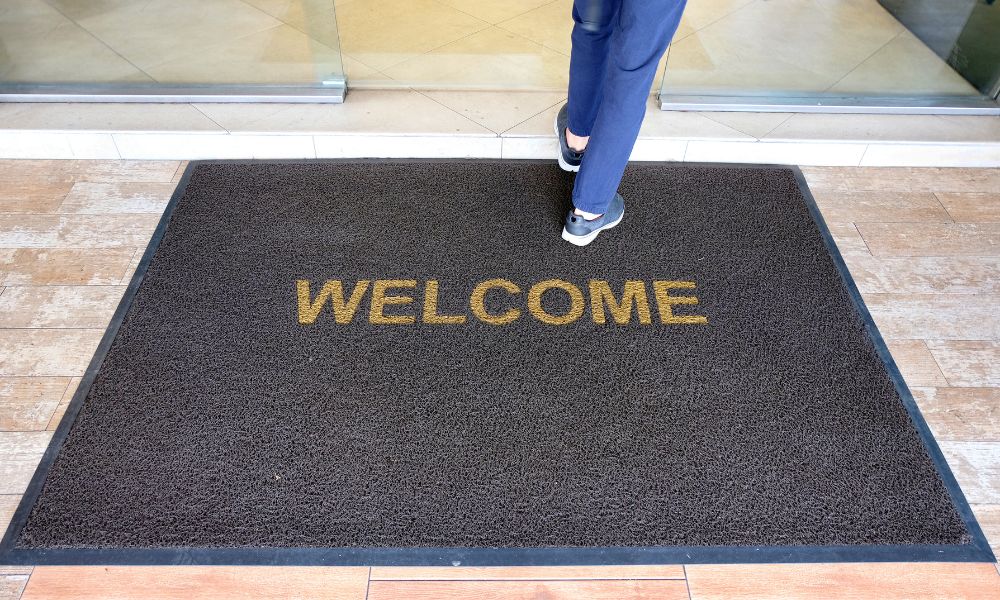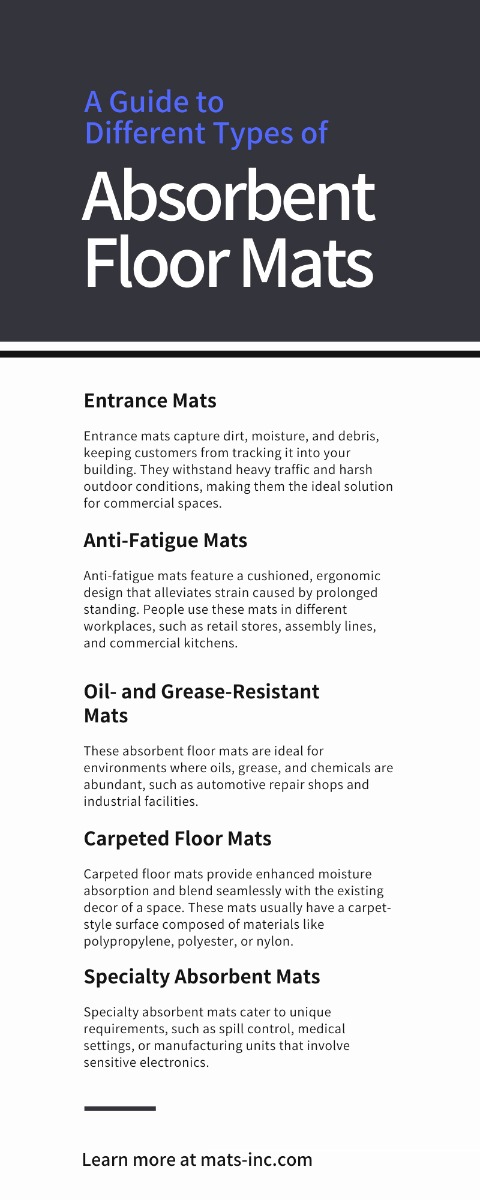Different Types of Absorbent Floor Mats & Their Uses

If you’re a business owner, it’s important to know the different types of absorbent floor mats and their uses in commercial settings. Absorbent mats can be vital for protecting your employees and customers from slips and falls on wet floors. These products provide an added layer of safety and reduce disruptions caused by spills or tracked-in moisture. In this guide, you’ll learn about the different types of absorbent floor mats, their advantages and disadvantages, and tips on choosing the one that best suits your needs.
Benefits of Using Absorbent Floor Mats
Absorbent floor mats are an essential part of maintaining a safe and clean environment in a variety of commercial establishments. Here are some of the top benefits of using these mats in your business.
Safety
Absorbent floor mats keep floors dry, reducing the risk of slip and fall accidents. This is particularly important in high-traffic areas and places where liquid spills are common, such as restaurants, bars, and industrial workspaces.
Cleanliness
These mats help you maintain a clean environment by absorbing spills, dirt, and debris. This can keep your establishment looking professional and well-kept, which is crucial for impressing clients, customers, or visitors.
Durability
High-quality absorbent floor mats can withstand heavy use and last for a long time. This means that you can rely on them to provide consistent performance over time, even in high-traffic areas.
Comfort
Absorbent floor mats feature cushioning to provide more comfortable and supportive surfaces for employees to stand on. These ergonomic benefits can reduce fatigue and discomfort, improving productivity and overall employee wellness.
Five Types of Absorbent Floor Mats
Absorbent floor mats are beneficial additions to any commercial facility. But before selecting mats for your business, it helps to know about the different types of absorbent floor mats and what each one brings to the table. Let’s take a look at five common types of mats and their advantages and disadvantages.
Entrance Mats
Entrance mats capture dirt, moisture, and debris, keeping customers from tracking it into your building. They withstand heavy traffic and harsh outdoor conditions, making them the ideal solution for commercial spaces. Key features of entrance mats include:
- High absorbency levels trap moisture and prevent slippery surfaces
- Rubber backing for increased slip resistance
- Durable materials, such as polypropylene and nylon, for long-lasting performance
Anti-Fatigue Mats
Anti-fatigue mats feature a cushioned, ergonomic design that alleviates strain caused by prolonged standing. People use these mats in different workplaces, such as retail stores, assembly lines, and commercial kitchens. Plus, the mats’ absorbent feature aids in retaining clean and dry surfaces. Anti-fatigue mats exhibit some unique characteristics, such as:
- Comfortable, supportive material to aid in reducing physical strain
- Resistance to chemicals, oils, and grease
- Slip-resistant backing so that employees maintain stable footing
Oil- and Grease-Resistant Mats
These absorbent floor mats are ideal for environments where oils, grease, and chemicals are abundant, such as automotive repair shops and industrial facilities. The mat’s surface and backing materials resist substances that cause degradation, ensuring longevity. Key features of grease- and oil-resistant mats include:
- High absorption capacity for oils and other liquids
- Resistance to chemical and oil degradation
- Textured surfaces to improve traction and reduce slippage
Carpeted Floor Mats
Carpeted floor mats provide enhanced moisture absorption and blend seamlessly with the existing decor of a space. These mats usually have a carpet-style surface composed of materials like polypropylene, polyester, or nylon. You can place carpeted mats in various locations, such as lobbies, office corridors, and residential spaces. Benefits of carpeted floor mats include:
- Aesthetic appeal
- Ability to trap dirt and moisture, keeping the surrounding floor clean
- Easy to clean and maintain
Specialty Absorbent Mats
Specialty absorbent mats cater to unique requirements, such as spill control, medical settings, or manufacturing units that involve sensitive electronics. Some examples of specialty mats include spill control mats for containing liquid spills, ESD (Electrostatic Discharge) mats for preventing static buildup, and water-absorbent mats for medical applications. Features of specialty absorbent mats include:
- Designed for specific applications or environments
- Highly effective for their intended purpose
- Customized material composition to suit unique requirements
Choosing the Right Absorbent Floor Mat for Your Business
Now that you know about the different types of absorbent mats, you may wonder which ones you should choose for your facility. Selecting the perfect absorbent floor mats for your business operations comes down to several factors. Consider the following when making your decision.
Purpose
Determine the primary purpose for the absorbent floor mat. Different mats meet different needs, such as oil absorption in a workshop or water absorption in a restaurant.
Material
Absorbent floor mats come in a range of materials, including polypropylene, rubber, and vinyl. Each material has its own benefits and drawbacks in terms of durability, absorbency, and resistance to specific substances that you should consider.
Size
You must choose the appropriate size for your space. This means taking into account factors such as where you’ll place it, how much foot traffic it will see, and if it needs to fit specific dimensions.
Thickness and Cushioning
Depending on the work environment and its employees, your business may benefit from a mat with extra cushioning for added comfort, while other establishments may prioritize a thinner, heavier-duty mat for durability. The thickness you choose is up to your business’s needs.
Safety Features
Mats with beveled edges and anti-slip surfaces can provide an additional layer of safety to prevent tripping or slipping accidents.
Maintenance
Some absorbent mats are machine washable, while others require spot cleaning or specific cleaning methods. Make sure to choose a mat with maintenance requirements that work with your operations.
Protecting your workplace from accidents is critical for any business. Investing in the right type of absorbent floor mat ensures the safety and comfort of your employees while enhancing the overall appearance of your establishment. Now that you know about the different types of absorbent floor mats, you can make an informed decision in selecting the best option for your workplace.
Finding the right absorbent floor mat for your business doesn’t have to be a daunting task. At Mats Inc., we provide an extensive selection of durable, high-performance water absorbent floor mats designed to meet any and all requirements. With our large variety of materials, sizes, and custom options, you can find the perfect solution for your space. Contact us today to explore our mats and get the best matting solutions for your business.f



